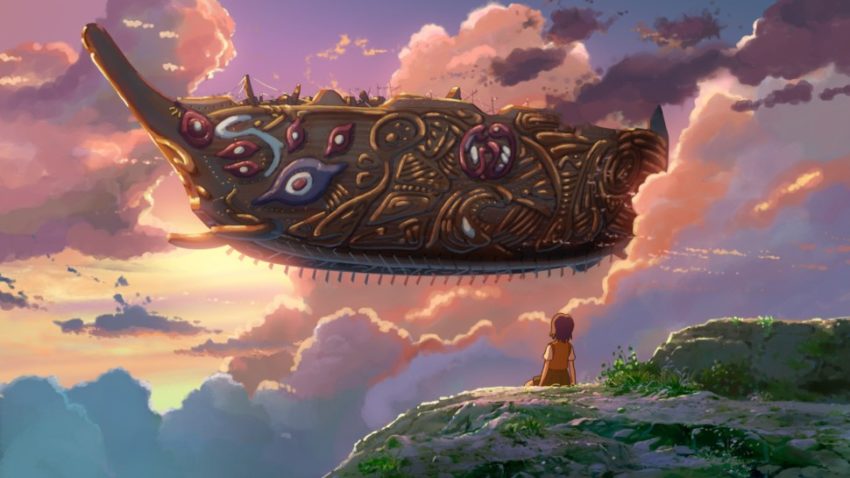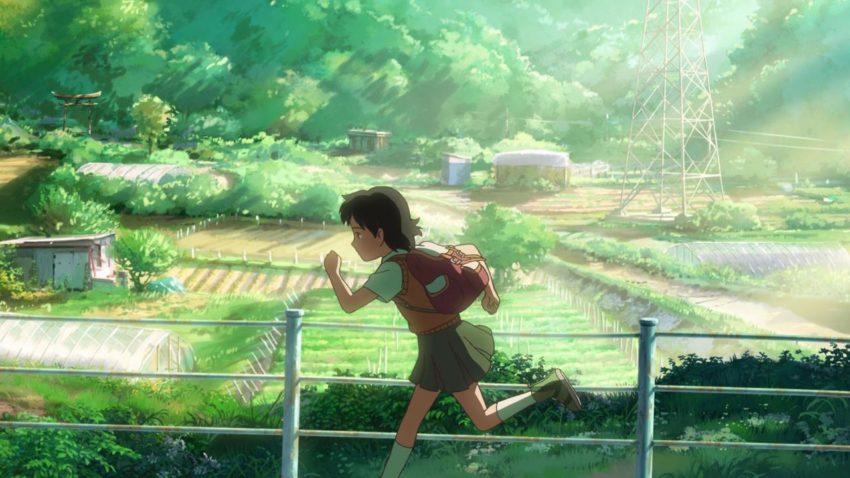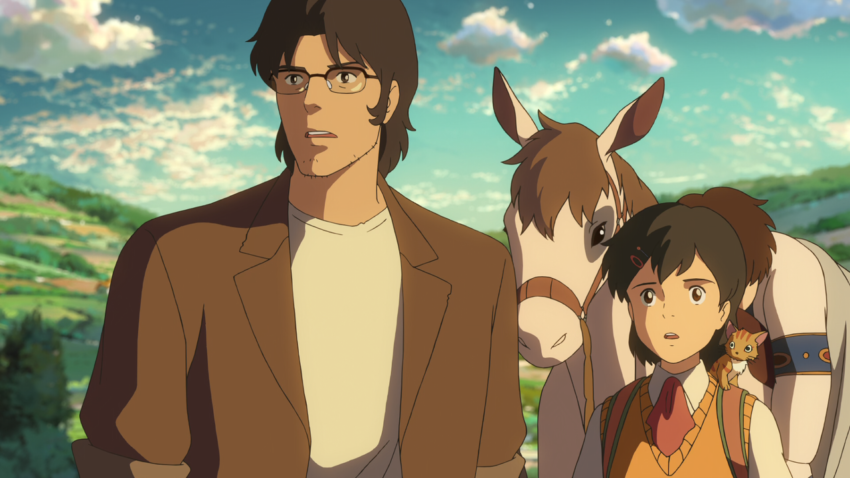Children Who Chase Lost Voices
February 5, 2021 · 0 comments
By Shelley Pallis.

Children Who Chase Lost Voices from Deep Below, also known as Journey to Agartha, was a landmark moment in the career of anime director Makoto Shinkai, his second chance at big-budget feature directing, six years after the relatively poor performance of his first full-length feature, The Place Promised in Our Early Days. These days, it has largely been overshadowed by his later successes, the mature short Garden of Words, and the global box-office hits of Your Name and Weathering with You, but it marks an intriguing turning point in Shinkai’s work – a sudden and unrepeated swerve into high fantasy and late-twentieth-century nostalgia.
In the countryside of 1970s Japan, schoolgirl Asuna lives practically alone – her father is dead, and her mother works overtime at the hospital to make ends meet. Her sole solace is the crystal radio set left behind by her father, which she uses to eavesdrop on distant broadcasts. Her life, however, is thrown into turmoil when she encounters a strange beast on the railway bridge that leads into town, and is she is saved by the intervention of a young man, whose body is later said to have been found in the river below.

Before long, she finds herself enmeshed in a conflict she doesn’t quite understand, as people from the lost underground kingdom of Agartha fight with would-be thieves of their precious clavis crystals – magical items said to open the gateway between life and death itself.
The Making Of documentary that accompanies Children makes much of Makoto Shinkai’s month-long trip to the Middle East in 2008, on a government boondoggle that found him screening his early fan-favourite 5cm per Second to animation students in Qatar, Syria and Jordan. It sites the genesis of Children in Shinkai’s unease at the sight of overseas audiences trying to get to grips with the first-world problems of his two teenage protagonists. This, supposedly, led him to begin considering the possibility of telling a more universal story, less rooted in the imagery and culture of contemporary Japan. But Shinkai himself speaks more of the influence the subsequent 16 months he spent in London, over a year off the grid, away from his Japanese fans, where he literally went “back to school,” enrolling in a class to improve his English.
It’s these school days, he argues, that made him “reflect on the time when I was a clumsy teenager,” but also which led to him writing the first draft of the script in his free evenings at his London flat, after multiple visits to the British Museum to soak up global cultures. The first treatment began with the words “A boy from the ground, a girl from the sky” – a concept that would fade from the story in later drafts, but in which long-term Shinkai watchers might discern a foreshadowing of Weathering with You.

Shinkai’s original draft also drew on his memories of a book from his childhood, Goodbye, Pyramid Hat (1981), a children’s sci-fi work about an under-achieving teenage boy who is lured into a quest into the underground world of Agartha, a refuge for the descendants of the lost civilisation of Atlantis. Notably, the novel was suffused with meditations on the frailty of adults and the appeal of the afterlife – author Yoshiko Okkotsu was terminally ill with cancer during the writing process, and left the book unfinished at the time of her death. This, itself, was something of a memorable issue for Shinkai’s creative development, since even as a child, he had always felt that there was something wrong with the ending, which had been tacked on by Okkotsu’s publisher Ryohei Komiyama.
“Agartha” itself was not a concept originated by Okkotsu, but first mentioned in the writings of the 19th-century occultist Alexandre Saint-Yves d’Alveydre, who claimed that it was an underground paradise that would be revealed to mankind if it ever achieved a Golden Age of peace. It was Shinkai’s first encounter not only with folklore about a legendary underground world, but also with the idea of film-making as a career option – the characters in the book stop for a while to make an amateur movie.
However, when it comes to influences on the production of this film, there is an elephant in the room that has become less obvious as the era of the film’s production fades into the past. 2008 was not merely the year that Makoto Shinkai, wunderkind of fan-friendly anime, took a British sabbatical, it was also the year that Hayao Miyazaki released Ponyo, his “final” film, and announced that he was really retiring this time, honest, no backsies. In other words, Shinkai returned to Japan as the anime industry’s great hope.

The term “Next Miyazaki” is deeply unpopular among anime critics, but let’s put it this way, a thousand cinema managers all over Japan were proclaiming to their distributors that they didn’t give much of a toss who was the Next Anything, just as long as someone could supply them with that one domestic cartoon feature that was guaranteed to put bums on seats. Someone, anyone, needed to deliver something like Miyazaki numbers, because Miyazaki’s films had been the tentpoles keeping Japanese cinema afloat since Princess Mononoke in 1997. Ghibli films were pretty good news on video, too. So, could we have something like that? And could we have it by May 2011 in time for the summer vacation season?
Mamoru Hosoda was at work on Summer Wars. Takeshi Koike was just about to unleash Redline. Sunao Katabuchi had Mai Mai Miracle up his sleeve; Shinsuke Sato had Oblivion Island ready to go. These were all released in 2009, in the vacuum left behind by what was believed to be the end of the Ghibli gravy-train, a year which ended with Shinkai submitting his draft of the project that would become Children Who Chase Lost Voices. Other contenders for the crown arrived in 2010, Welcome to the Space Show and Ghibli’s own Arrietty. The pressure was on for Shinkai, who had retreated from features after the disappointing performance of 2004’s Place Promised in Our Early Days, to come up with something that would last two hours, look enough like a family film to force parents to accompany their kids to the cinema, and sell a lot of popcorn.
So, it should come as no surprise that Children starts off like a Miyazaki pastoral, as a perky schoolgirl stocks her secret hideaway on a balmy 1970s day in the countryside – this is Shinkai evoking his own childhood much as Miyazaki did with his 1950s setting for Totoro. But while Children might have been sold as a Miyazaki clone to investors, there’s much more of Shinkai in it, particularly in his approaches to love and loss – Asuna’s yearning for her lost father, her mother’s absence at her day-job. There’s also a real sense of the difference made by the digitisation of the film industry – Asuna’s daily life drags on for ten full minutes of quiet longueurs, tracking shots across bridges and countryside, little character moments of food and frolics, before she faces her first supernatural challenge.

Whereas Shinkai’s previous scripts had been solo efforts, this time he enlisted the help of Saya Matsuda, who would also collaborate with him on Garden of Words, but who is now better known as a live-action TV drama scenarist, and as the scriptwriter of the recent movie First Gentleman. At the time, her most prominent credits were on the anime PERSONA – trinity soul (2008) and a Haruhi Suzumiya video game. The Shinkai-Matsuda script has no qualms about front-loading its themes. New teacher Mr Morisaki has barely arrived at Asuna’s school before he is reading to his class from the ancient myths of the Kojiki, pointedly selecting the tale of the god Izanagi’s futile quest to rescue his dead wife Izanami from the Underworld.
At the time of the Japanese premiere of Children, Shinkai told the audience that it was unlike any of his other films, in the sense that he had previously focussed on the beauty of everyday life. However, in the years since, Children has looked less and less like an anomaly, as Shinkai himself returns to themes that he may not have even realised at the time would link it to his later work. Ever since Voices from a Distant Star, Shinkai has been poking at one of his most beloved themes – the distance between people and the yearning of thwarted lovers. As a sop to the lobby demanding a family film to fill the Miyazaki vacuum, Children points its camera firmly at a young girl on a magical adventure, but the real story, nestling behind the scenes, is that of Mr Morisaki’s quest to bring his wife back from the dead, for which the travails of Asuna are little more than a distraction. Mr Morisaki is a twisted representation of all of Shinkai’s other have-a-go heroes, a man who is ready to consider making a huge and selfish sacrifice at others’ expense if it will bring back his true love. It is, in fact, a really bold and (in hindsight) obvious precursor to the protagonist of Weathering with You, who is faced with a similarly controversial choice in that film’s finale.
Children Who Chase Lost Voices from Deep Below is released in the UK by Anime Limited.
anime, Children Who Chase Lost Voices, Japan, Journey to Agartha, Makoto Shinkai, Shelley Pallis
Leave a Reply